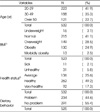Abstract
Objectives
This study examined the milk intake patterns with lactose and milk fat in Korean male adults using the following variables: milk intake level, awareness of lactose, and milk fat, health problems, and necessity of milk intake. In addition, the factors affecting milk intake were analyzed by multiple regression analysis.
Methods
The subjects were 532 males aged 20 years or older among the nationwide milk purchasing group. The subjects were 223 (41.9%) in the 20–29 year age group, 188 (35.3%) in the 30–49 year age group and 121(22.7%) in the over 50 year age group. The survey was conducted using ANOVA and multiple comparative analysis to examine the differences in age and multiple regression analysis was performed to investigate the factors affecting the intake of milk.
Results
The intake of milk in the subjects was 538.14 ± 494.23 ml per week. There were statistically significant differences in the subjects' age according to processed milk, low fat, nonfat milk, cheese, and ice cream. The perception of milk and lactose and milk fat was recognized as a good food for skeletal health when milk was consumed. Among the milk nutrients, lactose was highly recognized at the age of 20–29, and milk fat was recognized in those over 50 years. In addition to lactose and milk fat, calcium was the most highly recognized among the milk nutrients. Health problems associated with milk were skeletal health, obesity, and lactose intolerance. The perception of lactose intolerance was related to lactose intolerance and fatness, and the dietary behavior was unaffected.
Conclusions
This study examined the milk intake patterns of adult Korean males. Many variables were found to be related to the intake of milk. In this study, the milk intake was high when there was no problem with the perception and dietary behaviors of milk nutrition (lactose and milk fat). This study focused on lactose and milk fat, which are major nutrients in milk, and it is a new perspective study among milk-related research.
Figures and Tables
Acknowledgments
This research was supported by a grant (2016-01) from Korea Milk Marketing Board in 2016.
References
1. Ryu SH, Suh YS. Bone mineral density and nutritional state according to milk consumption in Korean postmenopausal women who drink coffee: Using the 2008~2009 Korea National Health and Nutrition Examination Survey. J Nutr Health. 2016; 49(5):347–357.

2. Lee JS, Yu CH, Chung CE. Relation between milk consumption and bone mineral density of female college students in Korea. J Nutr Health. 2006; 39(5):451–459.
3. Noh HY, Jang EJ, Shim JE, Park MK, Paik HY. Variations of serving sizes and composition of manufactured milk and soymilk products and implications for dietary assessment. Korean J Food Cult. 2008; 23(1):33–40.
4. The Korea Dairy and Beef Farmers Association. Milk story. The Korea Dairy and Beef Farmers Association;2018.
5. The Milk Self-Management Committee. Milk. The Milk Self-Management Committee;2018.
6. Kim SH, Kim HS. The value of milk and Korean dietary life. Korean J Dairy Sci. 1999; 17(1):16–31.
7. Kim SH, Kim WK, Kang MH. Effect of milk and milk products consumption on physical growth and bone mineral density in Korean adolescents. Nutr Res Pract. 2013; 7(4):309–314.

8. Baek HY. A study on the relationship between milk and dairy consumption and physical development in Korean elementary school students. The Korea Dairy and Beef Farmers Association;2004.
9. Kim MH, Bae YJ, Youn JY, Chung YS, Sung CJ. The study of life styles, dietary habits and nutrient intakes of Korean male college students related to the bone mineral density. Korean J Nutr. 2005; 38(7):570–577.
10. Kim HS, Kim MK, Jang DM, Kim NS, Kim JH, Lee BK. Effects of milk consumption on calcaneal quantitative ultrasound and bone turnover markers of women living in Asan. Korean J Community Nutr. 2007; 12(4):440–448.
11. Kim SL, Lee JE, Lee IS. The Relationship between of Calcium Intake and BMD in Middle-aged Women. J Korean Acad Community Health Nurs. 2005; 16(1):77–85.
12. Pettersson A, Kasperzyk JL, Kenfield SA, Richman EL, Chan JM, Willett WC. Milk and dairy consumption among men with prostate cancer and risk of metastases and prostate cancer death. Cancer Epidemiol Biomarkers Prev. 2012; 21(3):428–436.

13. Bonthuis M, Hughes MC, Ibiebele TI, Green AC, van der Pols JC. Dairy consumption and patterns of mortality of Australian adults. Eur J Clin Nutr. 2010; 64(6):569–577.

14. Kim SH, Yu CH, Kim JY, Lee SS. The effect of milk consumption on blood lipid levels of the Korean college women. Korean J Nutr. 2005; 38(7):561–569.
15. Kwon S, Lee JS. A study of the relationship between milk intake and the prevalence of chronic diseases in adults based on 5th and 6th Korea National Health and Nutrition Examination Survey data. J Nutr Health. 2017; 50(2):158–170.
16. Jung IK, Lee LH. A study on consumption behavior of milk and dairy products in college students. Korean J Food Cult. 2002; 17(5):551–559.
17. Kim TY, Kim HS. Comparison of calcium intake status among elementary students by participation in the school milk program. Korean J Food Cult. 2009; 24(1):106–115.
18. Nam ES, Kim HJ, Park SI. A study on consumption behavior for milk and dairy products among middle school students. Korean J Culinary Res. 2011; 17(3):236–258.
19. Jung IK, Lee LH. A study on consumption behavior of milk and dairy products in college students. Korean J Food Cult. 2002; 17(5):551–559.
20. Kim TY, Kim HS. Comparison of calcium intake status among elementary students by participation in the school milk program. Korean J Food Cult. 2009; 24(1):106–115.
21. Bonthuis M, Hughes MC, Ibiebele TI, Green AC, van der Pols JC. Dairy consumption and patterns of mortality of Australian adults. Eur J Clin Nutr. 2010; 64(6):569–577.

22. Yoon IK, Jang MH, Kim GT, Park DH, Seo JY, Park SY. Development and application of health belief model based milk education program for elementary, middle, and high school students. J Korean Home Econ Educ Assoc. 2007; 19(4):17–36.




 PDF
PDF ePub
ePub Citation
Citation Print
Print













 XML Download
XML Download